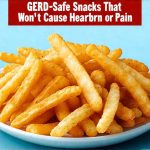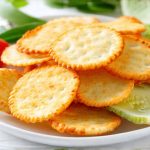Gastroesophageal reflux disease (GERD) is a common condition affecting millions, characterized by persistent heartburn, regurgitation, and sometimes more subtle symptoms like chronic cough or difficulty swallowing. Managing GERD often involves lifestyle modifications, including dietary adjustments to minimize triggers. While many lists focus on foods to avoid, finding satisfying snacks that don’t exacerbate symptoms can be challenging – particularly when navigating personal preferences and restrictions. Many individuals find relief by avoiding common irritants such as chocolate, citrus fruits, spicy foods, caffeine, alcohol, and mint, but this can leave a limited range of options for enjoyable snacking. The goal isn’t deprivation, but rather informed choices that support digestive comfort.
The difficulty lies in the fact that GERD triggers are highly individual. What bothers one person may not affect another. However, chocolate and mint often appear on “avoid” lists because they can relax the lower esophageal sphincter (LES), the muscle that prevents stomach acid from flowing back up into the esophagus. This relaxation makes reflux more likely. Finding alternatives requires understanding these mechanisms and exploring snacks that are generally well-tolerated while still providing flavor and satisfaction. It’s also crucial to remember that portion control plays a significant role; even GERD-friendly foods can cause issues if consumed in excessive quantities.
Understanding GERD-Friendly Snacking Principles
The foundation of GERD-friendly snacking revolves around several key principles. First, low acidity is paramount. Highly acidic foods are more likely to irritate the esophageal lining and trigger heartburn. Second, low fat content is beneficial as fatty foods can delay stomach emptying, increasing the risk of reflux. Third, snacks should ideally be easily digestible – meaning they don’t require a lot of effort from your digestive system. Finally, considering fiber intake is important; while generally healthy, excessive fiber can sometimes contribute to bloating and discomfort in sensitive individuals. Therefore, moderation is key.
Avoiding trigger foods is essential, but it’s also about proactively choosing snacks that support digestion. For example, certain fruits like bananas and melons are known for being gentle on the stomach. Similarly, plain crackers or dry toast can help absorb excess stomach acid. The focus shifts from what you can’t eat to what will actively contribute to a calmer digestive experience. This approach empowers individuals with GERD to enjoy snacking without constantly fearing flare-ups. It’s about building a personalized “safe list” of snacks based on individual tolerance and preferences. You might even find helpful guidance in resources like easy lunches tailored for sensitive digestive systems.
Ultimately, listening to your body is the most important principle. Keep a food diary to track what you eat and how it affects your symptoms. This will help you identify your personal triggers and refine your snacking choices accordingly. Don’t be afraid to experiment with different options until you find what works best for you.
Safe & Satisfying Snack Options
Many delicious and satisfying snack options exist that generally won’t worsen GERD symptoms, particularly when avoiding chocolate and mint. Plain crackers (saltines, graham crackers) paired with a small amount of peanut butter or almond butter offer a good balance of carbohydrates and protein, making them filling without being overly acidic or fatty. Bananas are another excellent choice, known for their soothing properties and low acidity. Melon (cantaloupe, honeydew) is hydrating and generally well-tolerated. Oatmeal – prepared with water rather than milk to reduce fat content – provides fiber and a comforting texture.
Beyond these staples, plain yogurt (Greek or regular) can be a good option, but choose unsweetened varieties to avoid added sugars which can sometimes trigger symptoms. A small handful of almonds or other nuts (excluding those heavily salted) provides healthy fats and protein, but portion control is crucial due to their fat content. Finally, rice cakes topped with avocado offer a light and satisfying snack. Remember that individual tolerance varies, so start with small portions and observe how your body responds. It’s also worth noting that preparation methods can impact tolerability; baked or steamed foods are generally easier to digest than fried ones. If you struggle with meal planning in general, exploring options like a gerd meal plan can be beneficial.
Identifying Personal Triggers & Building Your List
The “one-size-fits-all” approach simply doesn’t work when it comes to GERD and snacking. What one person tolerates, another may not. This is where the power of self-observation comes in. Maintaining a detailed food diary can be incredibly insightful. – Record everything you eat, including snack portions. – Note any accompanying symptoms, such as heartburn, regurgitation, bloating, or discomfort. – Track the timing of your symptoms relative to what you ate. – Look for patterns and identify potential triggers.
Once you’ve identified some possible triggers, eliminate them from your diet for a period (e.g., two weeks) and see if your symptoms improve. Then, gradually reintroduce them one at a time, carefully monitoring your response. This process helps pinpoint specific foods that exacerbate your GERD. Building your personalized safe list of snacks isn’t about restriction; it’s about empowering yourself with knowledge and making informed choices. It allows you to enjoy snacking without anxiety or discomfort. For more specialized dietary guidance, consider researching gut-friendly desserts that cater to sensitive digestive systems.
Portion Control & Timing Considerations
Even GERD-friendly snacks can cause issues if consumed in excessive quantities, or at the wrong time. Portion control is crucial, especially with foods that contain fat. Smaller, more frequent meals and snacks are generally better than large ones. Avoid overfilling your stomach, as this increases the pressure on the LES. The timing of your snacking also matters. – Avoid snacking right before bed. Lying down shortly after eating can increase the risk of reflux. – Allow at least 2-3 hours between your last meal or snack and bedtime. – Consider avoiding late-night snacking altogether if you’re prone to nighttime heartburn.
Furthermore, eating slowly and thoroughly chewing your food aids digestion and reduces the burden on your stomach. This simple habit can make a significant difference in managing GERD symptoms. Don’t rush through meals or snacks; savor each bite and pay attention to your body’s signals of fullness. Remember that snacking isn’t about mindless consumption; it’s about nourishing your body with foods that support your overall well-being. If you find yourself struggling with nighttime reflux, explore late night snacks designed to minimize symptoms.
Hydration & Its Role in Digestive Health
Staying adequately hydrated is vital for overall health, including digestive function. Water helps dilute stomach acid and aids in the movement of food through the digestive tract. However, certain beverages can exacerbate GERD symptoms. Avoid carbonated drinks as they increase abdominal pressure. Limit caffeine intake, as it can relax the LES. Similarly, avoid alcohol, which also has a similar effect.
Instead, opt for water, herbal teas (excluding peppermint or spearmint), and diluted fruit juices (avoiding citrus). Consider sipping water throughout the day rather than drinking large amounts at once. Proper hydration supports optimal digestion and can help minimize reflux episodes. It’s often overlooked but is a fundamental aspect of GERD management. You could also supplement your hydration with a gerd-friendly smoothie. Remember, listening to your body is crucial, and adjusting your snacking habits based on individual tolerance and preferences will lead to greater comfort and enjoyment.


















